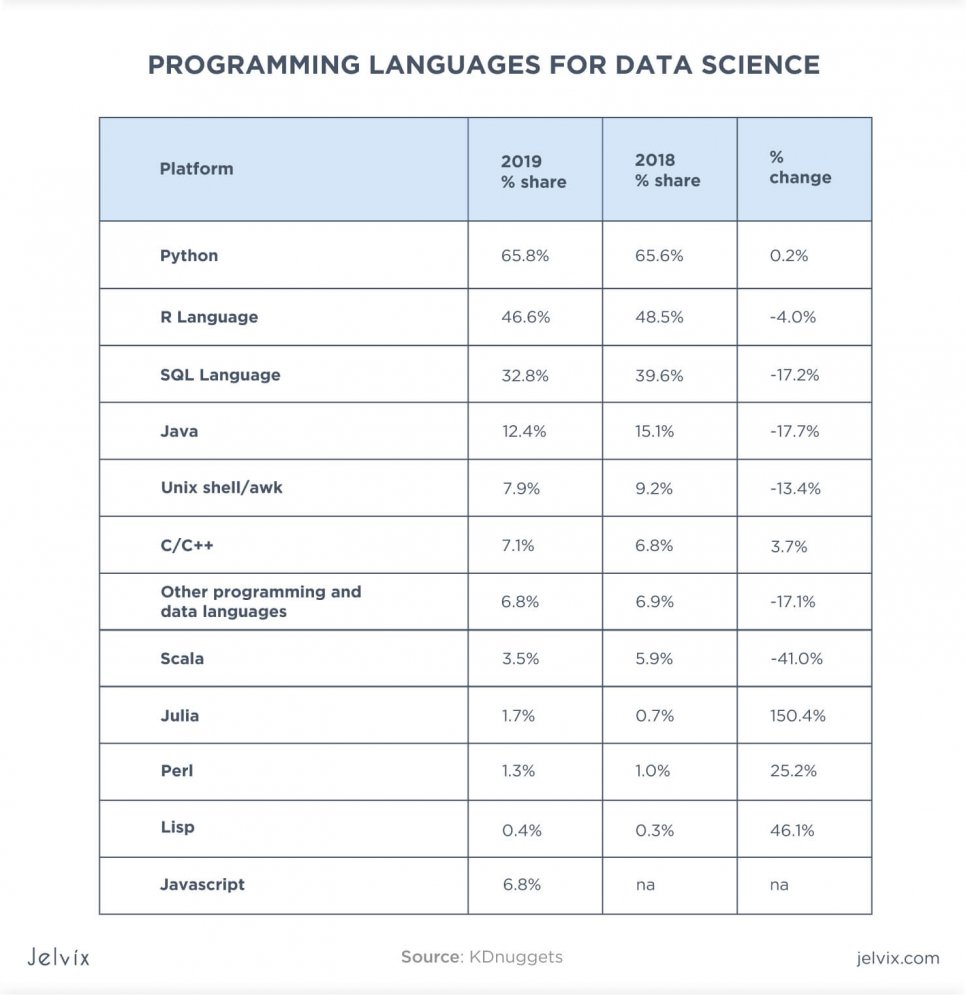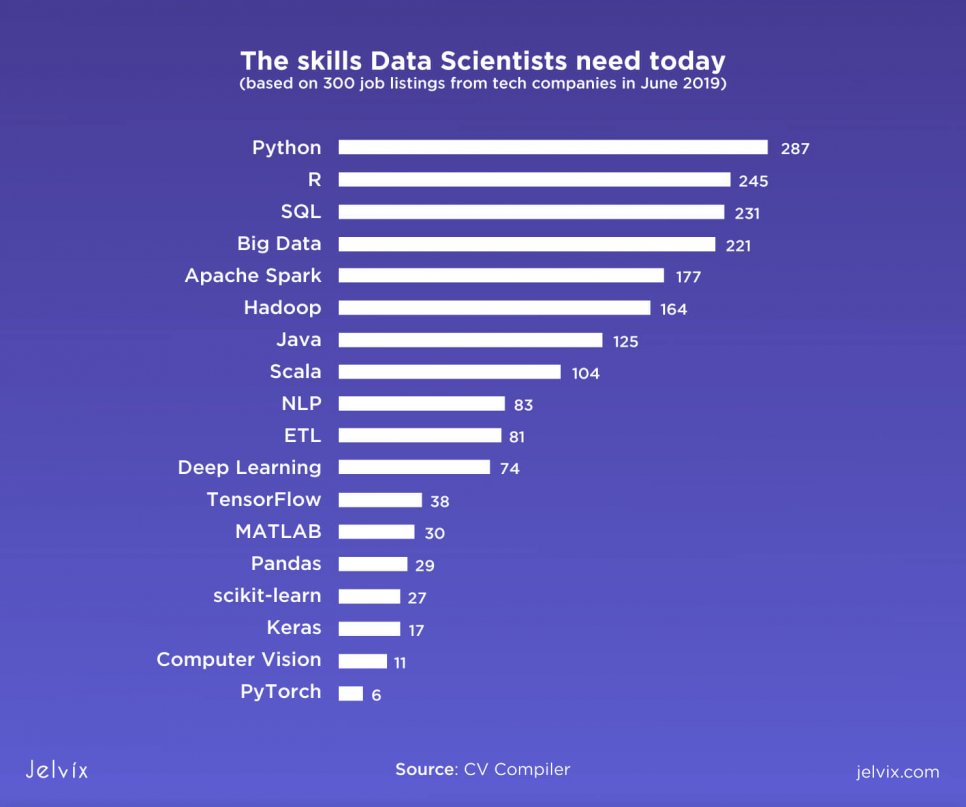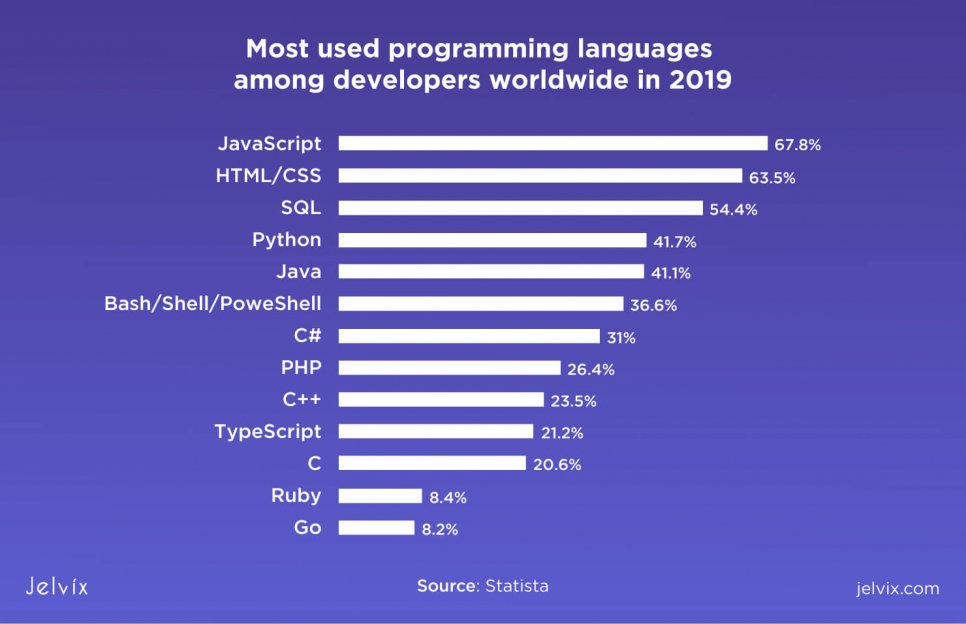Data science is not the hype of recent years. It is a total rethinking of approaches and principles of working with data for the benefit of both individuals and companies and the whole of humanity. The analysis of huge data sets gives access to non-obvious insights that can be used for any purpose – from improving the efficiency of the HR department of your company to defeating global problems.
For this reason, the data science specialist is considered the most sought-after profession of the next decade, and the best technological minds will continue to come up with new tools for more efficient work with data. In this article, we decided to make a list of data science programming languages, plus show the practical capabilities of each of them.
11 data science languages to choose from
There are a lot of programming languages for data science. And here is the study by Kdnuggets showing the most popular and frequently used of them. Python, as always, keeps leading positions. However, there are a lot of other useful tools that can be suitable for data science tasks, and they are discussed below as well.
1. Python
It is an ideal language to start diving into data science. In addition, the scope of its application is not limited to working with data only. The capabilities of Python allow you to write a program for machine learning tasks both from scratch and using various libraries and tools. Over the years, this language has been a leader in the frequency of use by programmers worldwide and in the number of tasks it allows to solve.
Facts and statistics:
- 66% of data scientists are using Python daily;
- 84% of them use it as the main language;
- It is predicted that Python will keep its leading position.
Pros:
- It is a universal language that allows you to create any project – from simple applications to machine learning programs;
- Python is clear and intuitive – it’s the best choice for beginners;
- All necessary additional tools are in the public domain;
- Add-on modules and various libraries can solve almost any problem.
Cons:
- Dynamic typing complicates the search for some errors associated with the misappropriation of various data to the same variables.
Tasks and projects it is suitable for:
Python is ideal for projects in which analytical and quantitative calculations should be a strength, for example, in the field of finance. What is more, Python is used for artificial intelligence development, which is one of the most promising innovations used in the financial sector. Besides, this language is used by Google and YouTube to improve internal infrastructure. ForecastWatch analytics uses this language to work with weather data.
2. R
R is also one of the top programming languages for data science. Also, it is the most powerful tool for statistical analysis of the existing ones. R is not just a language but a whole environment for statistical calculations. It allows you to perform operations on data processing, mathematical modeling, and work with graphics as well.
Facts and statistics:
- In 2014, R was the highest-paid technology to possess;
- It is used by 70% of data miners;
- R has more than 2 million users across the globe.
Pros:
- R is open-source and allows you to work with many operating systems, thanks to the fact that this tool is cross-platform;
- Statistics is the strength of this technology. Built-in functions allow you to perfectly visualize any data.
Cons:
- The main problems of R are safety, speed, and the amount of memory spent.
Tasks and projects it is suitable for:
For instance, it is possible to create a credit card fraud detection system using R or a sentiments analysis model to get insights on what users really think of a product or service.
Most often, programmers are ardent supporters of either one or the other programming language. However, it is worth recognizing that each of them has its strong points, as well as weaknesses. For example, R users sometimes crave object-oriented features built into the Python language. Similarly, some Python users dream of a wide range of statistical distributions available in R. This means that it is quite possible to combine the two leading technologies in one project to get a unique complemented set of functions.
So how can this be done in practice? There are two basic ways:
- R in Python
- Python with R
Simply put, each of these languages has a special package directory, some of which make it easy to use packages in another language. Thus, the project gets more flexibility and easy interchangeability when it is necessary to solve an atypical problem for one of the languages while using the other.
3. SQL
The structured query language is one of the key tools for working with big data because it combines analytical capabilities with transactional ones. In addition, SQL skills are one of the key requirements for a data science specialist.
Pros:
- Standardization is one of the main advantages of the language;
- High speed due to direct access to data;
- Simplicity and flexibility of the technology;
- Compliance of data science workflow.
Cons:
- Practicing programmers say that the analytical capabilities of SQL are limited by the functions of summing, aggregating, counting, and averaging data.
Tasks and projects it is suitable for:
Basically, SQL is used for data management in online and offline apps. Thus, the choice of this tool as one of the best languages for data science will depend on the project specifics.
4. Java
Being a high-performance language, Java may be the right choice for writing machine learning algorithms. Plus, it is perfectly possible to combine Java code with specialized data science tools.
Facts and statistics:
- Due to its wide applicability, Java is one of the most frequently used programming languages worldwide, according to the statistics for 2019. By the way, SQL and Python mentioned above are on this list as well;
- Java is believed to be good for big data and IoT as well;
- 95% of companies use Java for web and mobile application development. However, there are no statistics on Java usage for data science and big data due to the relative novelty of these concepts.
Pros:
- Java pays great attention to security, which is a key advantage when working with sensitive data.
Cons:
- Java is not suitable for highly specialized statistical solutions.
Tasks and projects it is suitable for:
This technology is suitable when there is an initial intention to integrate the created product with existing solutions.
5. JavaScript
It is quite unexpected to see the most popular general-purpose programming language as the best programming language for big data, isn’t it? Yes, some experts believe that it will take a long time until this language takes an honorable place in the arsenal of data science experts, but now there are enough native libraries to help solve various problems when working with big data and machine learning. And popular Tensorflow.js is one of them.
Pros:
- JavaScript is perfect for data visualisation;
- There are a lot of packages for statistical analysis and machine learning;
- Tensorflow is able to help with the creation of web-based AI projects with simplified functions.
Cons:
- Many experts believe that JavaScript should remain in its place and not to pry into high technology.
Tasks and projects it is suitable for:
This tool is a good fit when a project is created at the intersection of the web and big data technologies.
6. Matlab
As the name implies, Matlab is the best programming language for data science when it comes to the need for the most profound mathematical operations. This technology is powerful for data analysis, image processing, and mathematical modeling.
Pros:
- This tool is not used for general-purpose programming, which makes it a highly-specialized language for working with big data.
Cons:
- The computation speed will decrease with a large amount of data;
- You need a license to use this product.
Tasks and projects it is suitable for:
Matlab is suitable for applications that need strong arithmetic support – for example, signal processing. It can also be used for solutions from the educational and industrial sectors.
7. Scala
The best feature of Scala is the ability to run parallel processes when working with large data arrays. Since Scala is working on JWM, it provides access to the Java ecosystem. What is more, Scala is created in such a way that data science can perform a certain operation using several different methods. That provides greater flexibility for the developmental process.
Pros:
- Scala combines an object-oriented and functional programming language, and this makes it one of the most suitable languages for big data;
- There are a lot of libraries for Scala that are suitable for data science tasks, for example, Breeze, Vegas, Smile.
Cons:
- Scala is difficult to learn, plus the community is not so wide. Thus, it will be necessary to look for answers to many questions on your own in case of difficulties.
Tasks and projects it is suitable for:
Scala is great for projects when the amount of data is sufficient to realize the full potential of the technology. With significantly less data, Python or R is likely to be more efficient.
8. Julia
It is a fairly new, dynamic, and highly effective tool among programming languages for data analytics. Initially, Julia was designed as a language for scientific programming with speed sufficient to meet the needs in modeling in an interactive language, followed by the inevitable processing of code in a compiling language such as C or Fortran. That is why the result of working with this language is ideally combined with the Python and C language libraries.
Pros:
- You do not need a license to use this tool;
- Julia language works with data faster than Python, JavaScript, Matlab, R, and is slightly inferior in performance to Go, Lua, Fortran, and C;
- Numerical analysis is the strength of technology, but Julia also copes well with general-purpose programming.
Cons:
- Due to the fact that this is a fairly new tool, users note a narrow community, possible problems when searching for errors and malfunctions, as well as a limited set of options;
- Modeling is done using Python libraries, with logical losses in quality and performance;
- Partially implemented visualization: thanks to the PyPlot, Winston, and Gadfly libraries, data can be displayed in 2D graphics.
Tasks and projects it is suitable for:
This technology is ideal for projects in the field of finance, plus there is great hope that Julia will be able to compete fully with Python and R when it becomes more mature.
9. SAS
SAS, just as R, is a data analysis programming language, and its flexible possibilities of working with statistics are its main advantage. The only difference between SAS and R is that the first one is not open-sourced.
Pros:
- Despite the fact that this is one of the oldest languages, developers have the opportunity to use a unique package of functions for advanced analytics, predictive modeling, and business analytics.
Cons:
- It is a closed source software – however, it is offset by a large number of libraries and packages for statistical analysis and machine learning.
Tasks and projects it is suitable for:
SAS is suitable for projects which have high demands for stability and security.
10. Octave
It is the main alternative to Matlab that we have already mentioned above. In general, both of these technologies do not have extremely fundamental differences, just some exceptions.
Pros:
- You do not need a license to use the product.
Cons:
- If you need to continue working with code created with Matlab using Octave, be prepared for the fact that some functions may differ.
Tasks and projects it is suitable for:
Like Matlab, Octave can be used in projects with a relatively small amount of data if strong arithmetic calculations are needed.
Read more about the most common software development strategies and take a look at their benefits and drawbacks.
11. Swift
Swift is the main language for developing applications for operating systems such as iOS, macOS, watchOS, and tvOS. However, today the capabilities of this technology are significantly expanded. Big data does not have to exist in the cloud – it can exist in user’s smartphones. Therefore, Swift can be used to create mobile applications for the aforementioned operating systems when there is a need to connect big data and artificial intelligence.
Pros:
- Python-like syntaxis, but compared to Python, it is a more efficient, stable, and secure programming language;
- Huge community;
- Since Swift is native to iOS, it is very easy to deploy the created application on mobile devices with this operating system;
- The open-source Swift internal compiler and static typing allow you to create custom AI chipsets at build time;
- It is possible to efficiently use C and C ++ libraries in combination with Swift.
Cons:
- It is a fairly new technology, but this did not prevent it from becoming one of the favorite tools of iOS developers;
- It is possible to use Swift only for operating systems that were released after iOS7.
Tasks and projects it is suitable for:
Improving memory operations means fewer opportunities for unauthorized access to data. More efficient error handling implemented in Swift significantly reduces the number of crashes and the emergence of critical scenarios. Unpredictable behavior is minimized. This means that this technology is ideal for creating mobile applications that work with sensitive user data and are based on artificial intelligence.
Conclusion
Modern data science specialists have a large selection of technologies for implementing a wide variety of tasks. Both the efficiency and the cost of the development project will depend on the chosen programming language or framework as well. Thus, this is the point you should pay attention to. For example:
- If you are going to analyze a huge data array and make a lot of statistical calculations, then R is the best choice (sometimes in conjunction with Python);
- Python is highly suitable for NLP and intensive data processing with the help of the neural network;
- Java and Scala are suitable for the solutions that need the greatest performance with their further integration into the already existing apps.
Our team of data science experts has extensive experience in solving various problems. So, if you want to give your business more fuel in the form of data, think about creating an appropriate solution and contact us for advice today!
Need a certain developer?
Use our top talent pool to get your business to the next level.
























